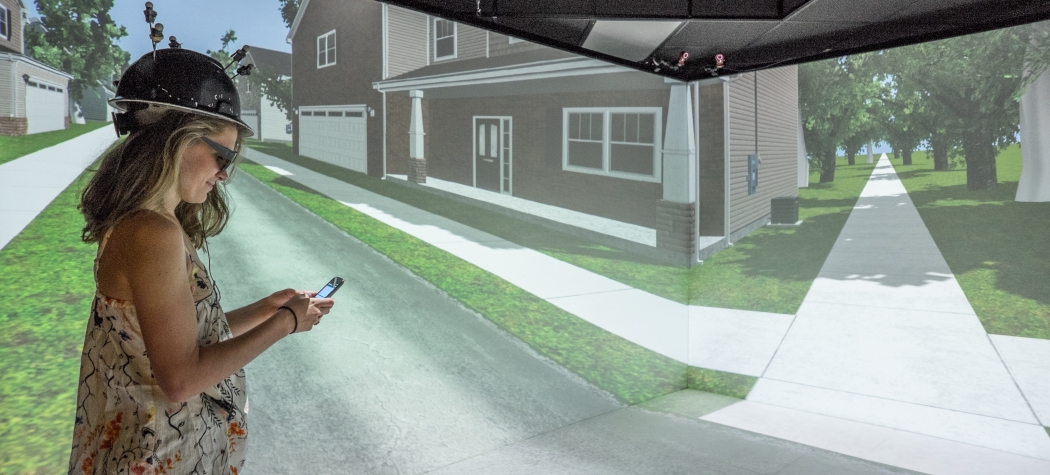

Long gone are the days when we would look both ways before crossing the street. The only direction most of us look is down, ceaselessly staring into the infinite depths of our screens. Distracted walking might not seem as dangerous as distracted driving, but it could be a contributing factor in the surge of pedestrian deaths and injuries seen over the last four years, according to the Governors Highway Safety Association.
But could the very technology that distracts us also alert us to danger? In a study published last week in the journal Human Factors, a team of computer scientists tried to determine if sending warning signs to a distracted person’s phone would help them safely cross a busy roadway.
“Pedestrians stand at the edge of the road, one second from death, a lot of time,” says Joseph Kearney, study co-author and professor of computer science at the University of Iowa. “Cars are whizzing by, and one single, false step could be dangerous.”
Don’t worry: researchers didn’t push pedestrians into a stream of oncoming traffic to test their theory. Kearney works at the Hank Virtual Environments Lab, which utilizes what’s called “virtual environment technology” to study how folks cross busy streets. Wearing virtual reality glasses and head mounted displays, preoccupied participants had to navigate a 3D neighborhood while texting. If they were about to make a dangerous road crossing, a loud warning signal sounded from their phone.
Some of the results were as expected—pedestrians heeded warnings and ultimately made safer crossings. But what Kearney didn’t anticipate was the participants’ reactions to the warning signals once they had already started crossing the road.
“The kicker was, once they made the overt motion to move, they almost never stopped and returned to the curb, even when they got a warning,” he says. “We also found they looked at the road much less when they have this alerting system. The concern is what we call ‘outsourcing our cognition’—you allow the phone to make the decision for you.”
It seems counter-intuitive to keep walking if there’s a speeding car coming at you, and in the study, it was. More than a third of the 300 test crossings resulted in a collision, which Kearney says was a much higher rate than other studies conducted in the simulator. In the real world, that translates to a lot of pedestrian pancakes. And even though participants knew they weren’t in any actual danger, Kearney says the collisions were still a shock, with many of them trying to leap out of the way of virtual vehicles.

Warning signals sound out when pedestrians attempt to make an unsafe crossings.
Kearney says the instinct to keep crossing instead of turning back may have to do with what’s called response inhibition, which in very basic terms suggests that it’s difficult to stop a motor function once it starts. Even if the alternate action—like aborting an unsafe crossing—could save your life, Kearney says very few participants instinctually did so.
For those who insist on walking and staring into the soul of your phone at the same time, don’t fret too much—in the grand scheme of things, pedestrian deaths are pretty rare. But they’re also very preventable, and they’re becoming more common.
There were close to 7,000 pedestrian deaths in 2016, an 11 percent increase since 2015, according to the National Highway Traffic Safety Administration. The increase is the largest recorded in 40 years, with pedestrian deaths now accounting for 15 percent of all traffic fatalities annually.
Of course, we can’t blame all of this on smartphones; adverse weather, distracted drivers, and increases in numbers of people travelling by foot are just a few of many factors contributing to the rise. We don’t have exact numbers on how many people are killed each year as a result of distracted walking. But that’s not to say it isn’t being taken seriously.
Last year, Honolulu became the first city in the U.S. to ban distracted walking. If you’re caught looking at your phone while crossing the street, you could be fined up to $99. Montclair, CA quickly followed suit, doling out fines for even wearing headphones in a crosswalk. There’s a 100-foot-long phone lane at an amusement park in Chongqing, China, to prevent people from smashing into each other while walking and smartphoning—to be fair, it is pretty hard to snarf a corndog and Snapchat at the same time.
What Kearney’s studying—known as V2P (vehicle-to-pedestrian) technology—already exists between cars. V2V (vehicle-to-vehicle) enables cars to communicate wirelessly to detect danger and help drivers avoid accidents. There’s already a Samsung app designed for New Yorkers called “Look Up,” which prompts distracted pedestrians to take notice when they reach an intersection. Kearney says the cellphone technology they’ve been testing is ready for use, it’s just a matter of whether smartphone manufacturers deem it worthwhile to implement.
Neil Gaffney with the Federal Highway Administration says with pedestrians and cyclists accounting for an increasing proportion of traffic fatalities, V2P technology will “eventually be a viable solution to improve safety.” The national highway administration estimates that these new systems have the potential to prevent almost half of pedestrian crashes.
“Pedestrian detection systems can be implemented in vehicles, infrastructure, or with pedestrians themselves to provide warnings,” Gaffney says. “These include both in-vehicle systems such as blind spot and forward collision warnings, and handheld devices that can provide warnings for pedestrians. These are young, but promising applications for this developing technology.”
In the meantime, let’s all look back on some long lost advice: remember to look both ways before crossing the street!
